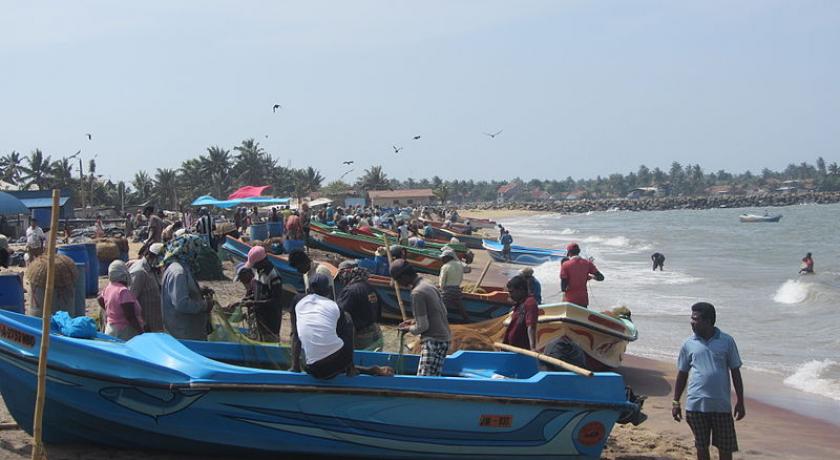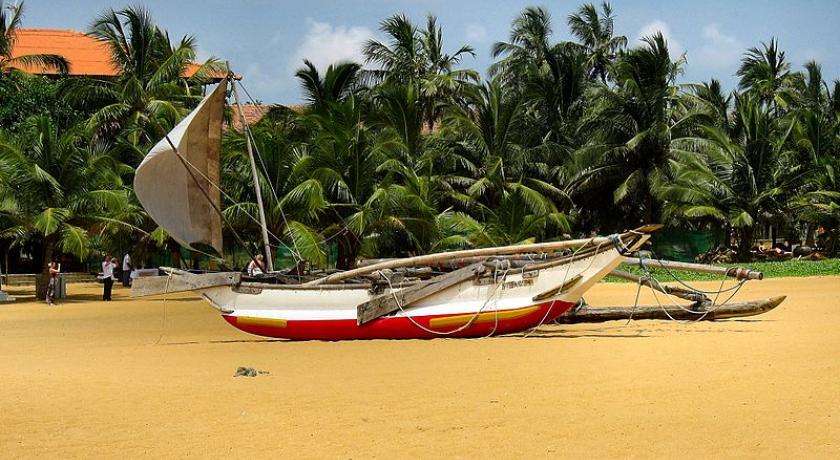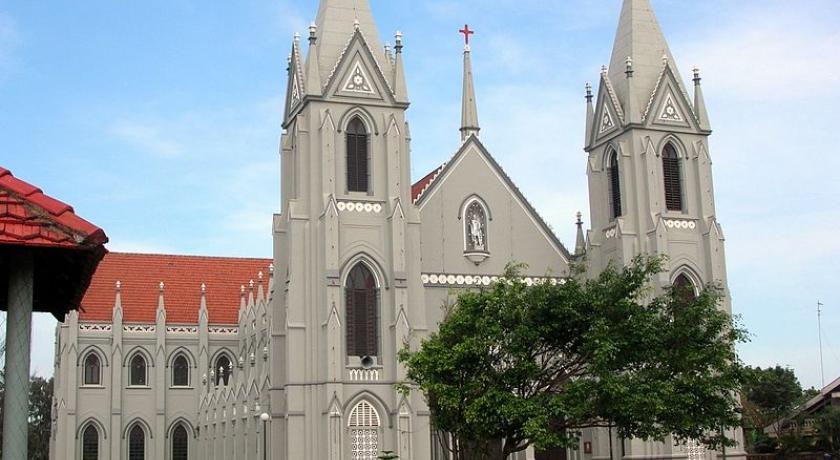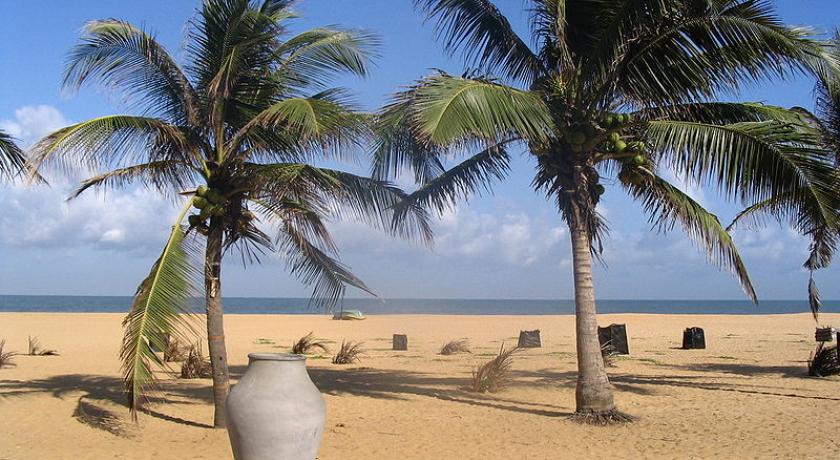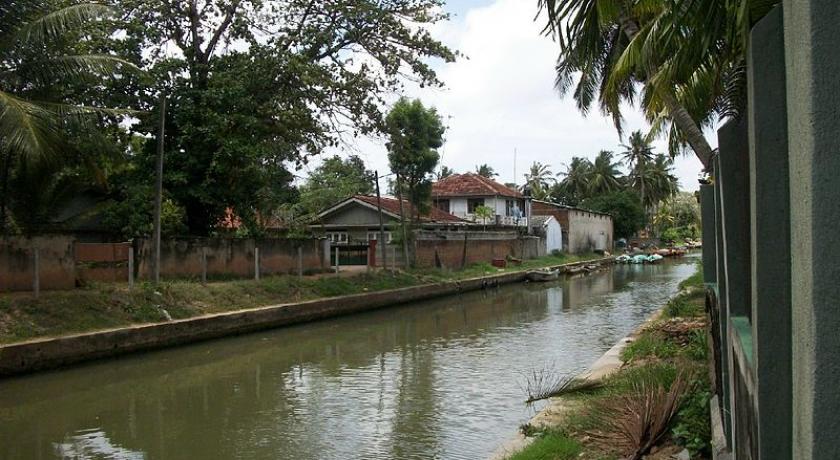Description
Negombo (Sinhala: මීගමුව [ˈmiːɡamuʋə]; Tamil: நீர்கொழும்பு [nir koɭumbu]) is a major city in Sri Lanka, on the west coast of the island and at the mouth of the Negombo Lagoon, in Western Province, Sri Lanka. Negombo is the fourth largest city in Sri Lanka and it is the largest city in Gampaha District. Negombo is also the administrative capital centre of the Negombo Division. It is one of the major commercial hubs in Sri Lanka with about 144,551 inhabitants within city limits.
It is approximately 35 km north of Colombo City. Negombo is known for its huge and old fishing industry with busy fish markets and sandy beaches. Negombo is the most westernized, vibrant city and it is one of the major tourist destination in the country. The International Airport of Sri Lanka is in Negombo Metropolis.
Etymology
The name "Negombo" was first used by the Portuguese; the Sinhala name Mīgamuva (මීගමුව) means the "Group of Bees". It was named a few centuries before in the ancient kings' era. The army of King Kavantissa found bee honey in a canoe near the seashore, for Viharamahadevi who was pregnant with the prince Dutugamunu. Because of this, the place was named "Mee-Gomuwa".
History
The wild cinnamon that grew in the region around Negombo was said to be "the very best in the universe as well as the most abundant" and for centuries attracted a succession of foreign traders and colonial powers. The shallow waters of the Negombo Lagoon provided safe shelter for seafaring vessels and became one of the key ports (along with Kalpitiya, Puttalam, Salavata, Kammala, Colombo, Kalutara, Beruwala and Galle) from which the Singhalese kingdoms conducted external trade.
The first Muslim Arabs (the Moors) arrived in Ceylon in the seventh and eighth centuries and eventually dominated the east-west trade routes. Many chose to settle in the coastal areas, and their legacy can be seen today; their descendants the Sri Lankan Moors remain the largest minority group in Negombo.
The Moors' long-held monopoly over the cinnamon trade, and the circuitous and largely overland route by which it was transported to Europe and the Mediterranean, added greatly to its cost. It encouraged a Portuguese takeover in the late fifteenth and early sixteenth century.
Landing in the early 1500s, the Portuguese ousted the Moors, constructed a fort in Negombo and took over the trade of cinnamon to the West. During the Portuguese occupation, the Karawa (traditional fishing clan of Negombo) embraced Catholicism almost without exception. So successfully were they converted that today Negombo is sometimes known as 'Little Rome' and nearly two thirds of its population profess a Catholic faith.
The Portuguese restructured the traditional production and management of cinnamon and maintained their control over the trade for more than a century. The decline of their power began in the 1630s when warfare between the Portuguese and the Kingdom of Kandy reached a stalemate. the King of Kandy turned to the Dutch for help. The Dutch captured Negombo from the Portuguese in 1646 and negotiated an armistice with Portugal for ten years. During this period the King of Kandy sought to provoke conflict between the nations by passing through the territories of the one to attack the other. On one occasion he captured the fort of Negombo and sent the head of the Dutch commander Adrian Vander Stell to his countrymen in Galle. Although the Dutch managed to regain control of Negombo from the King by diplomatic means, hostilities continued. In particular, the disruption of the cinnamon trade was a favourite method of the King to harass the Dutch.
The legacy of the Dutch colonial era can be seen in the Dutch Fort, constructed in 1672, other buildings and the extensive canal system that runs 120 km from Colombo in the South, through Negombo to Puttalam in the north.
Throughout the eighteenth century the demand for cinnamon from Ceylon outstripped the supply, and its quality appears to have suffered. Other factors, including the continued hostility from the Kandian government and a rival cinnamon trade from China, led to a 40% decline in the volume of cinnamon exported between 1785 and 1791. Despite attempts to clear land around Negombo and create cinnamon plantations, by the time the British commander Colonel Stuart took over the trade in 1796, it was clear that the industry was in decline. Poor policies put in place by Frederick North the first Governor of British Ceylon exacerbated the problem. By the 1830s commercial interest had moved elsewhere.
Following the British takeover of the Kingdom of Kandy in 1815, Negombo lost its strategic value as an outpost of Colombo. However it continued to develop in commercial influence. The Negombo fishery was at the heart of the seafood trade in Ceylon, and many migrant fisherman arrived annually with the profits of their ventures going into the small, prosperous town. In 1907 Negombo was connected to the massive railway project that was linking the island together under British control and encouraging the growth of plantations in coconuts, tea and coffee.
Geography and climate
Negombo is about 2 meters above sea level, and Negombo's geography is a mix of land and water. The Dutch canal flows in the heart of the city. The lagoon is one of the most scenic landmarks of Negombo. There are over 190 species of wildlife and plenty of birds in its mangroves. The northern border of the city is formed by the Ma Oya river which meets the Indian Ocean.
Negombo features a tropical rainforest climate under the Köppen climate classification. The city receives rainfall mainly from the Southwestern monsoons from May to August and October to January. During the remaining months there is a little precipitation due to Convective rains. The average annual precipitation is about 2400 millimetres. The average temperature varies 24 to 30 degrees Celsius, and there are high humidity levels from February to April.
Negombo Lagoon
Negombo Lagoon is large semi-enclosed coastal water body with plenty of natural resources. The lagoon is fed by number of small rivers and the Dutch canal. It is linked to the Indian ocean by a narrow channel to the north, near Negombo city. The lagoon and the marsh land area also support local agriculture and forestry. It has extensive mangrove swamps and attracts a wide variety of water birds. The lagoon supports so many distinct species of flora , fauna and as well as another species of birds and variety of animals. Negombo Lagoon is a major local and tourist attraction primarily for sightseeing and boating tours.
The fishermen who are based at the Negombo lagoon live in abject poverty in shanty thatch palm villages along the water's edge. They rely mainly on their traditional knowledge of the seasons for their livelihood, using outrigger canoes carved out of tree trunks and nylon nets to bring in modest catches from September through April. Their boats are made in two forms – oruvas (a type of sailing canoe) and paruvas (a large, man-powered catamaran fitted with kurlon dividers).
For generations the lagoon has provided the fishers with a plentiful supply of crabs, shrimps, lobsters, cuttlefish and many native species of fish. The men are regularly forced to head out to the ocean to fish, often losing money in the chartering process. In recent years, the villagers have supplemented the income earned from fishing by collecting 'toddy', or palm sap, which is used to brew arrack.
Transport
The Airport Expressway (E03) opened in 2013 links the capital Colombo through the Katunayake Interchange with Negombo city minimizing travelling time to just 20 or 30 minutes. There is a highway bus service running between from Negombo to Matara (the southern tip of the country) through Galle using the Southern Expressway.The A3 main road from Colombo, goes through Negombo, extends to Jaffna, and Trincomalee via Anuradhapura. Negombo is connected with some of the B grade roads, and there is a good road network in and around Negombo City.
The Bus Terminal Complex of Negombo is one of the best in Sri Lanka. It has ultra modern architectural features, state-of-the-art amenities and multiple facilities for passengers and public. It is served by many bus routes, connecting with some major destinations like Colombo, Kandy, Kurunegala, Matara, Galle, Kegalle, Ratnapura, Polonnaruwa, Avissawella, Ampara, Mannar, Kalpitiya, Tangalle, Kekirawa, Hatton, Balangoda, Kataragama, Welimada, Kuliyapitiya, Chilaw etc.
Three railway stations serve Negombo city: Kurana, Negombo Downtown, and Kattuwa. Negombo Downtown Station is the main railway station of the Colombo–Puttalam railway line. It serves Kalutara, via Colombo from south and to Puttalam, via Chilaw from north. The Sri Lanka Railway Department has introduced an intercity express train between Chilaw and Colombo with a stop at Negombo Downtown Station.
The Negombo Downtown Station is close to the central Bus Terminal Complex. Negombo is the closest city to the Bandaranaike International Airport.
Religion
Negombo is a multi-religious city. Since the beginning of European colonization, the township of Negombo has had a majority of Roman Catholics along with Buddhists, Hindus and Muslims.
Catholic & Christian Churches
Negombo has been given the name Little Rome due to the highly ornate Portuguese-era Roman Catholic churches such as St. Mary's Church found in the township and because the majority are the Roman Catholics. St. Sebastian Church at Sea Street and Katuwapitiya, Saint Stephen’s Church, Negombo, Grand Street St.Mary's cathedral Church, St.Anne's churches at Kurana and Palangatura and St.Anthony's church Dalupotha are the biggest parishes in Negombo. There are over 25 Roman Catholic churches in the city.
There is a branch of The Church of Jesus Christ of Latter-day Saints in Negombo. The church building is just west of the intersection of Ave Maria street and Old Chilaw street. There are also Methodist churches, Baptist churches, and the other Anglican churches in Negombo.
Buddhist Temple
Agurukaramulla Raja Maha Viharaya is a famous Buddhist temple bringing Buddhists from all over Sri Lanka to Negombo every year. Abhayasekararamaya temple (Podipansala), Sri Sudarshanaramaya, Dutugamunu viharaya and Asapuwa are famous Buddhist temples in the city.
Hindu Kovil (Temple)
There are so many Hindu temples (Kovil) in Negombo: Kali temple, Ganapathi (Pillaiar) Temple, Muththumari Amman Temple, Murugan (Kandaswami) Temple, Karumari Amman Temple are some of them.
Muslim Masjid (Mosques)
There are nine Jummah Mosques in Negombo. The Kamachchoda Jummah Masjid in Kamachchoda, Negombo is one of the oldest in Sri Lanka. Another old Msajid in Negombo is the Udayar Thoppuwa Mosque, Mirigama Road, Dheen Junction, Negombo which was built in 1846 by Maththicham Saleem Lebbe Muhammed Thamby Vidane and the old building which was built in 1846 is still in use.
Tourism
Negombo is a major tourist destination in Sri Lanka. This city is an ideal and liberal place with luxury, tropical life style, for those who want quick access to and from the country's main international airport and also to Colombo city. The 100 km canal network running through the city is still used. Outrigger canoes and modern water-craft ply this route daily, for trade and tourism. Remnants of colonization include the Dutch fort built in 1672, as well as centuries-old Portuguese and Dutch houses, administrative buildings, churches and the ceiling frescoes of St. Mary's Cathedral , Bodhirajarama Maha Viharaya (Angurukaramulla Temple) – මීගමුව බෝධිරාජාරාමය.
Negombo is home to the country's second-largest fish market, locally famous as the Lellama (Lel-La-Ma), at the north end of the lagoon. There are daily fish auctions, which give tourists a chance to meet the area's fishers, buy fish and even organise fishing trips into the lagoon and the ocean beyond. Other nearby attractions open to visitors include Muthurajawela Marshland, which is part of a 6,000-hectare (14,826-acre) reserve. The protected mangroves of the lagoon are home to over 190 species of wildlife.
Negombo offers one of the best beaches on the west coast of Sri Lanka. It draws tourists who stop over for a day on their way to or from the airport. Some quiet stretches of the beach are maintained by the tourist hotels, while others are always busy with fishermen and their equipment. Water-sports and diving are popular among visitors, with a few well-preserved coral reefs and a 50-year-old shipwreck that can be seen in the distance also known as Kudapaduwa (Ku-Da-Paa-Du-We) that serves as an artificial reef for many varieties of fish. Mora Wala (Mo-Ra-Wa-La) and Beach Park are very interesting places.
There are local handicrafts, batiks and jewellery boutiques on the beaches and the shops.
Address
Negombo
Sri Lanka
Lat: 7.202840328 - Lng: 79.870925903


